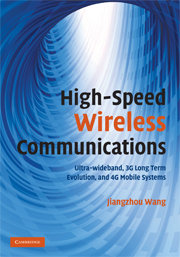Book contents
- Frontmatter
- Contents
- Preface
- Acknowledgements
- List of abbreviations
- Part I Introduction
- Part II UWB communications
- Part III Evolved 3G mobile communications
- Part IV 4G mobile communications
- 9 Optimal and MMSE detection for downlink OFCDM
- 10 Hybrid detection for OFCDM systems
- 11 Coded layered space-time-frequency architecture
- 12 Sub-packet transmission for hybrid ARQ systems
- Index
- References
9 - Optimal and MMSE detection for downlink OFCDM
from Part IV - 4G mobile communications
Published online by Cambridge University Press: 27 May 2010
- Frontmatter
- Contents
- Preface
- Acknowledgements
- List of abbreviations
- Part I Introduction
- Part II UWB communications
- Part III Evolved 3G mobile communications
- Part IV 4G mobile communications
- 9 Optimal and MMSE detection for downlink OFCDM
- 10 Hybrid detection for OFCDM systems
- 11 Coded layered space-time-frequency architecture
- 12 Sub-packet transmission for hybrid ARQ systems
- Index
- References
Summary
The performances of optimum and per sub-carrier MMSE (or pcMMSE) detectors for OFCDM systems are compared in this chapter. In OFCDM systems, the existence of MCI in the frequency domain due to a frequency selective channel on different sub-carriers dramatically degrades the system performance. To suppress MCI, an optimum or MMSE detector is employed in this chapter. A quasi-analytical BER expression is derived in the presence of imperfect channel estimation. Numerical results show that with a linear computation complexity, the MMSE detector can improve the system performance by suppressing MCI, although it cannot perform as well as the optimum detector. Thus, in systems with a small number of code channels, the optimum detector can be employed to achieve better performance, whereas the MMSE detector is more suitable for systems with a large number of code channels. The MMSE detector is also more robust to different configurations of system parameters than the optimum detector. Moreover, it is found that pilot channel power should be carefully determined by making trade-off between the channel estimation quality and received SNR for each data channel.
Introduction
OFCDM is proposed for future broadband wireless communications. Inherited from OFDM, in OFCDM systems a high-speed data stream is divided into several parallel low-speed substreams, whose bandwidth is far smaller than the channel bandwidth, so each substream can be regarded as passing through a frequency nonselective (flat) fading. As a result, the multipath interference in frequency selective fading channels is effectively avoided.
Information
- Type
- Chapter
- Information
- High-Speed Wireless CommunicationsUltra-wideband, 3G Long Term Evolution, and 4G Mobile Systems, pp. 231 - 252Publisher: Cambridge University PressPrint publication year: 2008
